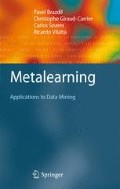Current data mining (DM) and machine learning (ML) tools are characterized by a plethora of algorithms but a lack of guidelines to select the right method according to the nature of the problem under analysis. Applications such as credit rating, medical diagnosis, mine-rock discrimination, fraud detection, and identification of objects in astronomical images generate thousands of instances for analysis with little or no additional information about the type of analysis technique most appropriate for the task at hand. Since real-world applications are generally time-sensitive, practitioners and researchers tend to use only a few available algorithms for data analysis, hoping that the set of assumptions embedded in these algorithms will match the characteristics of the data. Such practice in data mining and the application of machine learning has spurred the research community to investigate whether learning from data is made of a single operational layer — search for a good model that fits the data — or whether there are in fact several operational layers that can be exploited to produce an increase in performance over time. The latter alternative implies that it should be possible to learn about the learning process itself, and in particular that a system could learn to profit from previous experience to generate additional knowledge that can simplify the automatic selection of efficient models summarizing the data.
This book provides a review and analysis of a research direction in machine learning and data mining known as metalearning.1 From a practical standpoint, the goal of metalearning is twofold. On the one hand, we wish to overcome some of the challenges faced by users with current data analysis tools. The aim here is to aid users in the task of selecting a suitable predictive model (or combination of models) while taking into account the domain of application. Without some kind of assistance, model selection and combination can turn into solid obstacles to end users who wish to access the technology more directly and cost-effectively. End users often lack not only the expertise necessary to select a suitable model, but also the availability of many models to proceed on a trial-and-error basis. A solution to this problem is attainable through the construction of metalearning systems that provide automatic and systematic user guidance by mapping a particular task to a suitable model (or combination of models).
Access this chapter
Tax calculation will be finalised at checkout
Purchases are for personal use only
Preview
Unable to display preview. Download preview PDF.
Rights and permissions
Copyright information
© 2009 Springer-Verlag Berlin Heidelberg
About this chapter
Cite this chapter
(2009). Metalearning: Concepts and Systems. In: Metalearning. Cognitive Technologies. Springer, Berlin, Heidelberg. https://doi.org/10.1007/978-3-540-73263-1_1
Download citation
DOI: https://doi.org/10.1007/978-3-540-73263-1_1
Publisher Name: Springer, Berlin, Heidelberg
Print ISBN: 978-3-540-73262-4
Online ISBN: 978-3-540-73263-1
eBook Packages: Computer ScienceComputer Science (R0)

